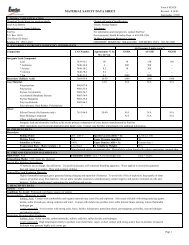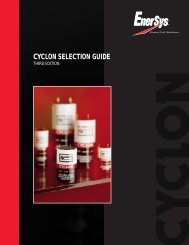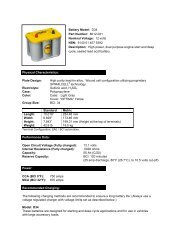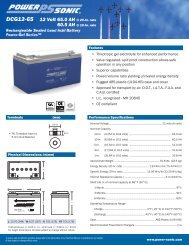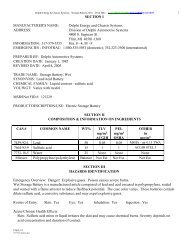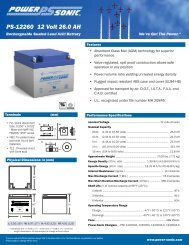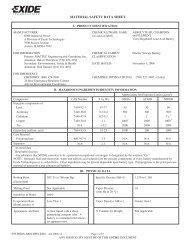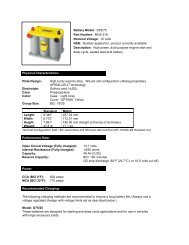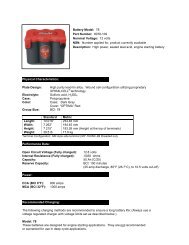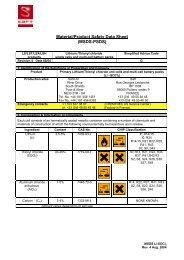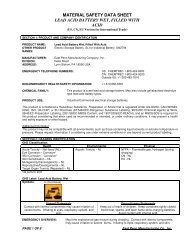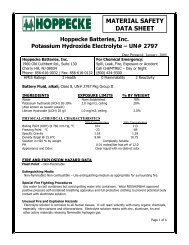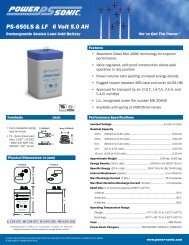Yuasa Battery MSDS - Falcon Electric
Yuasa Battery MSDS - Falcon Electric
Yuasa Battery MSDS - Falcon Electric
Create successful ePaper yourself
Turn your PDF publications into a flip-book with our unique Google optimized e-Paper software.
Form # 853024<br />
MATERIAL SAFETY DATA SHEET<br />
Revised: 8/10/05<br />
Supersedes: 12/22/04<br />
I. PRODUCT IDENTIFICATION<br />
Chemical Trade Name (as used on label):<br />
Nonspillable Lead-Acid <strong>Battery</strong><br />
Chemical Family/Classification:<br />
<strong>Electric</strong> Storage <strong>Battery</strong><br />
Manufacturer's Name/Address:<br />
Telephone:<br />
EnerSys<br />
For information and emergencies, contact EnerSys'<br />
P.O. Box 14145 Environmental, Health & Safety Dept. at 610-208-1996<br />
2366 Bernville Road 24-Hour Emergency Response Contact:<br />
Reading, PA 19612-4145<br />
CHEMTREC DOMESTIC: 800-424-9300 CHEMTREC INT'L: 703-527-3887<br />
II. HAZARDOUS INGREDIENTS/IDENTIFY INFORMATION<br />
Air Exposure Limits (ug/m 3 )<br />
Components<br />
CAS Number Approximate % by OSHA ACGIH NIOSH<br />
Wt. Or Vol.<br />
Inorganic Lead Compound:<br />
Lead 7439-92-1 45 - 60 50 150 100<br />
* Lead Dioxide 1309-60-0 15 - 25 50 150 100<br />
* Antimony 7440-36-0 2 500 500 --<br />
* Arsenic 7440-38-2 0.2 10 200 --<br />
* Calcium 7440-70-2 0.2 -- -- --<br />
* Tin 7440-31-5 0.2 2000 2000 --<br />
Electrolyte (Sulfuric Acid) 7664-93-9 10-30 1000 1000 1000<br />
Case Material: 5-10 N/A N/A N/A<br />
Polypropylene 9003-07-0<br />
Polystyrene 9003-53-6<br />
Styrene Acrylonitrile 9003-54-7<br />
Acrylonitrile Butadiene Styrene 9003-56-9<br />
Styrene Butadiene 9003-55-8<br />
Polyvinylchloride 9002-86-2<br />
Polycarbonate, Hard Rubber, Polyethylene --<br />
Other:<br />
Silicon Dioxide (Gel batteries only) 7631-86-9 20-40 N/A N/A N/A<br />
Sheet Molding Compound -- N/A N/A N/A<br />
(Glass reinforced polyester)<br />
Inorganic lead and electrolyte (sulfuric acid) are the primary components of every battery manufactured by EnerSys.<br />
Other ingredients may be present dependent upon battery type. Contact your EnerSys representative for additional information.<br />
III. PHYSICAL DATA<br />
Electrolyte:<br />
Boiling Point: 203 - 240° F Specific Gravity (H2O = 1): 1.215 to 1.350<br />
Melting Point: N/A Vapor Pressure (mm Hg): 10<br />
Solubility in Water: 100% Vapor Density (AIR = 1): Greater than 1<br />
Evaporation Rate: (Butyl Acetate = 1) Less than 1 % Volatile by Weight: N/A<br />
Appearance and Odor:<br />
Manufactured article; no apparent odor. Electrolyte is a clear liquid with a sharp, penetrating, pungent odor.<br />
IV. FIRE AND EXPLOSION HAZARD DATA<br />
Flash Point: N/A Flammable Limits: LEL = 4.1% (Hydrogen Gas) UEL = 74.2%<br />
Extinguishing Media: CO2; foam; dry chemical<br />
Special Fire Fighting Procedures:<br />
If batteries are on charge, shut off power. Use positive pressure, self-contained breathing apparatus. Water applied to electrolyte generates<br />
heat and causes it to spatter. Wear acid-resistant clothing.<br />
Unusual Fire and Explosion Hazards:<br />
Highly flammable hydrogen gas is generated during charging and operation of batteries. To avoid risk of fire or explosion, keep sparks or other<br />
sources of ignition away from batteries. Do not allow metallic materials to simultaneously contact negative and positive terminals of cells and<br />
batteries. Follow manufacturer's instructions for installation and service.<br />
V. REACTIVITY DATA<br />
Stability: Stable<br />
Conditions To Avoid: Prolonged overcharge; sources of ignition<br />
Incompatibility: (Materials to avoid)<br />
Sulfuric Acid: Contact with combustibles and organic materials may cause fire and explosion. Also reacts violently with strong reducing agents,<br />
metals, sulfur trioxide gas, strong oxidizers and water. Contact with metals may produce toxic sulfur dioxide fumes and may release flammable<br />
hydrogen gas.<br />
Lead Compounds: Avoid contact with strong acids, bases, halides, halogenates, potassium nitrate, permanganate, peroxides, nascent hydrogen<br />
and reducing agents.<br />
Hazardous Decomposition Products:<br />
Sulfuric Acid: Sulfur trioxide, carbon monoxide, sulfuric acid mist, sulfur dioxide, and hydrogen.<br />
Lead Compounds: High temperatures likely to produce toxic metal fume, vapor, or dust; contact with strong acid or base or presence of nascent<br />
hydrogen may generate highly toxic arsine gas.<br />
Page 1
Form # 853024<br />
MATERIAL SAFETY DATA SHEET<br />
Revised: 8/10/05<br />
Supersedes: 12/22/04<br />
VI. HEALTH HAZARD DATA<br />
Routes of Entry:<br />
Sulfuric Acid: Harmful by all routes of entry.<br />
Lead Compounds: Hazardous exposure can occur only when product is heated, oxidized or otherwise processed or damaged to create dust, vapor<br />
or fume.<br />
Inhalation:<br />
Sulfuric Acid: Breathing of sulfuric acid vapors or mists may cause severe respiratory irritation.<br />
Lead Compounds: Inhalation of lead dust or fumes may cause irritation of upper respiratory tract and lungs.<br />
Ingestion:<br />
Sulfuric Acid: May cause severe irritation of mouth, throat, esophagus and stomach.<br />
Lead Compounds: Acute ingestion may cause abdominal pain, nausea, vomiting, diarrhea and severe cramping. This may lead rapidly to systemic toxicity and must<br />
be treated by a physician.<br />
Skin Contact:<br />
Sulfuric Acid: Severe irritation, burns and ulceration.<br />
Lead Compounds: Not absorbed through the skin.<br />
Eye Contact:<br />
Sulfuric Acid: Severe irritation , burns, cornea damage, and blindness.<br />
Lead Components: May cause eye irritation.<br />
Effects of Overexposure - Acute:<br />
Sulfuric Acid: Severe skin irritation, damage to cornea, upper respiratory irritation.<br />
Lead Compounds: Symptoms of toxicity include headache, fatigue, abdominal pain, loss of appetite, muscular aches and weakness, sleep<br />
disturbances and irritability.<br />
Effects of Overexposure - Chronic:<br />
Sulfuric Acid: Possible erosion of tooth enamel, inflammation of nose, throat and bronchial tubes.<br />
Lead Compounds: Anemia; neuropathy, particularly of the motor nerves, with wrist drop; kidney damage; reproductive changes in males and<br />
females.<br />
Carcinogenicity:<br />
Sulfuric Acid: The International Agency for Research on Cancer (IARC) has classified "strong inorganic acid mist containing sulfuric acid" as a<br />
Category I carcinogen, a substance that is carcinogenic to humans. This classification does not apply to liquid forms of sulfuric acid or sulfuric<br />
acid solutions contained within a battery. Inorganic acid mist (sulfuric acid mist) is not generated under normal use of this product. Misuse of the<br />
product, such as overcharging, may result in the generation of sulfuric acid mist.<br />
Lead Compounds: Lead is listed as a 2B carcinogen, likely in animals at extreme doses. Proof of carcinogenicity in humans is lacking at present.<br />
Arsenic: Listed by National Toxicology Program (NTP), International Agency for Research on Cancer (IARC), OSHA and NIOSH as a<br />
carcinogen only after prolonged exposure at high levels.<br />
Medical Conditions Generally Aggravated by Exposure:<br />
Overexposure to sulfuric acid mist may cause lung damage and aggravate pulmonary conditions. Contact of sulfuric acid with skin may aggravate<br />
diseases such as eczema and contact dermatitis. Lead and its compounds can aggravate some forms of kidney, liver and neurologic diseases.<br />
EMERGENCY AND FIRST AID PROCEDURES:<br />
Inhalation:<br />
Sulfuric Acid: Remove to fresh air immediately. If breathing is difficult, give oxygen.<br />
Lead: Remove from exposure, gargle, wash nose and lips; consult physician.<br />
Ingestion:<br />
Sulfuric Acid: Give large quantities of water; do not induce vomiting; consult physician.<br />
Lead: Consult physician immediately.<br />
Skin:<br />
Sulfuric Acid: Flush with large amounts of water for at least 15 minutes; remove contaminated clothing completely, including shoes.<br />
Lead: Wash immediately with soap and water.<br />
Eyes:<br />
Sulfuric Acid and Lead: Flush immediately with large amounts of water for a least 15 minutes; consult physician.<br />
Proposition 65:<br />
Warning: <strong>Battery</strong> posts, terminals and related accessories contain lead and lead compounds, chemicals known to the State of California to cause<br />
cancer and reproductive harm. Batteries also contain other chemicals known to the State of California to cause cancer. Wash hands after handling.<br />
VII. PRECAUTIONS FOR SAFE HANDLING AND USE<br />
Spill or Leak Procedures:<br />
Stop flow of material, contain/absorb small spills with dry sand, earth, and vermiculite. Do not use combustible materials. If possible, carefully<br />
neutralize spilled electrolyte with soda ash, sodium bicarbonate, lime, etc. Wear acid-resistant clothing, boots, gloves, and face shield. Do not<br />
allow discharge of unneutralized acid to sewer.<br />
Waste Disposal Methods:<br />
Spent batteries: Send to secondary lead smelter for recycling.<br />
Place neutralized slurry into sealed containers and handle as applicable with state and federal regulations. Large water-diluted spills, after<br />
neutralization and testing, should be managed in accordance with approved local, state and federal requirements. Consult state environmental<br />
agency and/or federal EPA.<br />
Page 2
Form # 853024<br />
MATERIAL SAFETY DATA SHEET<br />
Revised: 8/10/05<br />
Supersedes: 12/22/04<br />
VII. PRECAUTIONS FOR SAFE HANDLING AND USE (Cont.)<br />
Handling and Storage:<br />
Store batteries in cool, dry, well-ventilated areas with impervious surfaces and adequate containment in the event of spills. Batteries should<br />
also be stored under roof for protection against adverse weather conditions. Separate from incompatible materials. Store and handle only<br />
in areas with adequate water supply and spill control. Avoid damage to containers. Keep away from fire, sparks and heat.<br />
Precautionary Labeling:<br />
POISON - CAUSES SEVERE BURNS<br />
DANGER - CONTAINS SULFURIC ACID<br />
VIII. CONTROL MEASURES<br />
Engineering Controls:<br />
Store and handle in well-ventilated area. If mechanical ventilation is used, components must be acid-resistant.<br />
Work Practices:<br />
Handle batteries cautiously to avoid spills. Make certain vent caps are on securely. Avoid contact with internal components. Wear protective<br />
clothing when filling or handling batteries.<br />
Respiratory Protection:<br />
None required under normal conditions. When concentrations of sulfuric acid mist are known to exceed the PEL, use NIOSH or MSHA-approved<br />
respiratory protection.<br />
Protective Gloves:<br />
Rubber or plastic acid-resistant gloves with elbow-length gauntlet.<br />
Eye Protection:<br />
Chemical goggles or face shield.<br />
Other Protection:<br />
Acid-resistant apron. Under severe exposure emergency conditions, wear acid-resistant clothing and boots.<br />
Emergency Flushing:<br />
In areas where sulfuric acid is handled in concentrations greater then 1%, emergency eyewash stations and showers should be provided,<br />
with unlimited water supply.<br />
IX. OTHER REGULATORY INFORMATION<br />
NFPA Hazard Rating for Sulfuric Acid:<br />
Flammability (Red) = 0 Reactivity (Yellow) = 2<br />
Health (Blue) = 3<br />
Sulfuric acid is water-reactive if concentrated.<br />
U.S. DOT:<br />
EnerSys batteries that are classified as Nonspillable have been tested and meet the nonspillable criteria listed in CFR 49, 173.159 (d) (3) (i) and (ii).<br />
Nonspillable batteries are excepted from CFR 49, Subchapter C requirements, provided that the following criteria are met:<br />
1. The batteries must be protected against short circuits and securely packaged.<br />
2. Each battery and their outer packaging must be plainly and durably marked "NONSPILLABLE" or "NONSPILLABLE BATTERY".<br />
IATA:<br />
The exception from CFR 49, Subchapter C translates to no proper shipping name, no hazardous class, no UN number, no packing group and no hazardous labels<br />
when transporting a nonspillable battery.<br />
Contact your EnerSys representative for additional information regarding the classification of batteries.<br />
EnerSys batteries that are classified as Nonspillable have been tested and meet the nonspillable criteria listed in IATA Packing Instruction 806 and Special Provision<br />
A67. Nonspillable batteries must be packed according to IATA Packing Instruction 806.<br />
These batteries are excepted from all IATA regulations provided that the batteries' terminals are protected against short circuits.<br />
Contact your EnerSys representative for additional information regarding the classification of batteries.<br />
Page 3
Form # 853024<br />
MATERIAL SAFETY DATA SHEET<br />
Revised: 8/10/05<br />
Supersedes: 12/22/04<br />
IX. OTHER REGULATORY INFORMATION (Cont.)<br />
IMDG:<br />
EnerSys batteries that are classified as Nonspillable have been tested and meet the nonspillable criteria listed in Special Provision 238. Non-spillable batteries must<br />
be packed according to IMDG Packing Instruction P003.<br />
These batteries are excepted from all IMDG code provided that the batteries' terminals are protected against short circuits per PP16.<br />
Contact your EnerSys representative for additional information regarding the classification of batteries.<br />
RCRA:<br />
Spent lead-acid batteries are not regulated as hazardous waste by the EPA when recycled, however state and international regulations may vary.<br />
CERCLA (Superfund) and EPCRA:<br />
(a) Reportable Quantity (RQ) for spilled 100% sulfuric acid under CERCLA (Superfund) and EPCRA (Emergency Planning Community<br />
Right to Know Act) is 1,000 lbs. State and local reportable quantities for spilled sulfuric acid may vary.<br />
(b) Sulfuric acid is a listed "Extremely Hazardous Substance" under EPCRA, with a Threshold Planning Quantity (TPQ) of 1,000 lbs.<br />
(c) EPCRA Section 302 notification is required if 1,000 lbs. or more of sulfuric acid is present at one site. The quantity of sulfuric acid<br />
will vary by battery type. Contact your EnerSys representative for additional information.<br />
(d) EPCRA Section 312 Tier 2 reporting is required for batteries if sulfuric acid is present in quantities of 500 lbs. or more and/or if lead is<br />
present in quantities of 10,000 lbs. or more.<br />
(e) Supplier Notification: This product contains toxic chemicals, which may be reportable under EPCRA Section 313 Toxic Chemical<br />
Release Inventory (Form R) requirements.<br />
If you are a manufacturing facility under SIC codes 20 through 39, the following information is provided to enable you to complete<br />
the required reports:<br />
TSCA:<br />
CAA:<br />
Toxic Chemical<br />
CAS Number<br />
Lead 7439-92-1<br />
60<br />
Sulfuric Acid 7664-93-9<br />
10 - 30<br />
* Antimony 7440-36-0<br />
2<br />
* Arsenic 7440-38-2<br />
0.2<br />
If you distribute this product to other manufacturers in SIC Codes 20 through 39, this information must be provided with the first shipment<br />
of each calendar year.<br />
The Section 313 supplier notification requirement does not apply to batteries, which are "consumer products".<br />
* Not present in all battery types. Contact your EnerSys representative for additional information.<br />
Ingredients in EnerSys' batteries are listed in the TSCA Registry as follows:<br />
Components CAS Number TSCA Status<br />
Electrolyte: Sulfuric Acid (H 2 SO 4 ) 7664-93-9 Listed<br />
Inorganic Lead Compound:<br />
Lead (Pb) 7439-92-1 Listed<br />
Lead Oxide (PbO) 1317-36-8 Listed<br />
Lead Sulfate (PbSO 4 ) 7446-14-2 Listed<br />
Antimony (Sb) 7440-36-0 Listed<br />
Arsenic (As) 7440-38-2 Listed<br />
Calcium (Ca) 7440-70-2 Listed<br />
Tin (Sn) 7440-31-5 Listed<br />
Approximate % by Wt.<br />
EnerSys supports preventative actions concerning ozone depletion in the atmosphere due to emissions of CFC's and other ozone depleting<br />
chemicals (ODC's), defined by the USEPA as Class I substances. Pursuant to Section 611of the Clean Air Act Amendments (CAAA)<br />
of 1990, finalized on January 19, 1993, EnerSys established a policy to eliminate the use of Class I ODC's prior to the May 15, 1993 deadline.<br />
Page 4



